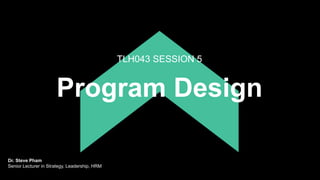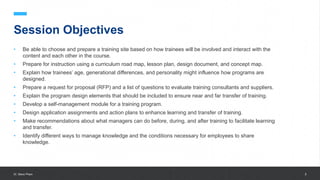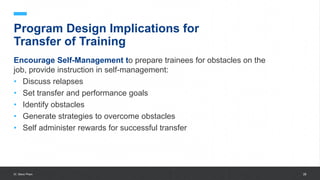The document summarizes key aspects of designing effective training programs, including:
1) Program design involves three phases - pre-training preparation, the learning event, and post-training transfer strategies. The training site and materials should be tailored to the audience.
2) Trainers and content should be carefully selected to match the learning objectives. The program structure and activities should engage trainees and enhance retention of the material.
3) Audience characteristics like age, personality, and generational differences influence the best learning approaches and environment. Pre-training sets expectations and post-training supports application.

![University of Gloucestershire 2
Readings & Preparation
Pre-readings: [core text] Chapter 5: Program Design & Case 5.1 Program
Redesign Reduces Costs.
In-class discussion preparation: Go to
https://www.allencomm.com/portfolio/dominos/ for an example of training for
new employees developed by AllenComm for Domino’s Pizza. Review the
examples of the Pizza Maker course that are provided. What features does
the Pizza Maker course include that help to enhance learning and transfer
of training? Identify each feature and discuss how it enhances learning,
transfer of training, or both.](https://image.slidesharecdn.com/session5programdesgin-230221115659-b4f0c857/85/Session-5-Program-Desgin-pdf-2-320.jpg)








































![University of Gloucestershire 43
Readings & Preparation
Pre-readings: [core text] Chapter 7 Traditional Training Methods &
Chapter 8 Technology-Based Training Methods & Case 7.1 Training
Methods for Bank Tellers.
In-class discussion preparation: Go to http://sans.org, the website for
the SANS Institute, which provides information security training. Under
“Find Training,” move down to “Training Roadmap” and click on one of the
courses listed. Review this information and then click on “Full Course
Information and Details.” What information is provided? How is it useful for
learners? For instructors?](https://image.slidesharecdn.com/session5programdesgin-230221115659-b4f0c857/85/Session-5-Program-Desgin-pdf-43-320.jpg)